INDIAN RAMBLE 2011-12
Part 1 Chennai to Andhra Pradesh
The Journey Begins Way Down South in Chennai, then Heads North to Andhra
Pradesh State
Cathay Pacific had the best deals on the long haul to India. I had first
bought a ticket to New Delhi in October to take in the festival season there,
but then cancelled that ticket after my father’s death. On November 22nd I finally headed across the
cold Pacific on a 19-hour flight, changed planes in Hong Kong, then continued
another four hours to Chennai in Tamil Nadu, India’s southernmost state.
In 1983 I had begun my very first visit to India from this city, then called Madras.
A prudent traveler arriving during the wee hours would have arranged
accommodations in advance, but I just got some cash at an ATM, hopped in old
taxi, and grabbed a likely looking hotel near the center. Some things are easy
in India. Chennai has relatively few sights compared to India’s other big three
“metros,” although it’
s still worth a few days sightseeing. My first day
was devoted just to recovering from the long flights. I set out on my second day to spiritual sites,
starting early morning at Ramakrishna Mutt Temple, where a monk was singing
inside the white building. Nearby at the Kapaleeshwarar Temple, entered through a towering
gopuram gateway covered in colorful statues of gods and saints, a Shiva lingam
took center stage,
lavished with milk, flowers, and chants of praise. A short walk to
the seaside led to San Thome Cathedral and a basement chapel with relics of St.
Thomas, the doubting apostle who arrived on the shores of India in the first
century AD. While in the beautiful soaring cathedral, the heavens opened up with a
deluge of rain. I splashed my way via an auto rickshaw to the Vivekananda House, a curious
ornate semi-circular building originally called the Ice House. You can imagine how homesick Brits living in a steamy tropical climate missed having a cool drink
in the days before refrigeration, but an enterprising American brought giant
blocks of New England ice by clipper beginning in 1833. Now the building houses
exhibits on the famous wandering monk, Swami Vivekananda, who had stayed here
in 1897.
On later days I swung by Fort St. George (1653) for some English
colonial history in the museum and the old stone church. Next I took in the Government
Museum for its collections of ancient stone and bronze statuary and modern art. Cultural
organizations in the city offered performances of Indian
classical music or dance, which I enjoyed. The most unusual had to be the one
with 109 keyboards: Children with electronic keyboards sat on terraced rows
playing Indian tunes to
an appreciative audience, then a representative from the Guinness World Book of
Records presented a certificate proclaiming this the biggest concert of
keyboards ever!
Visakhapatnam
An overnight train ride north up the coastal plain took me to me to
Visakhapatnam in Andhra
Pradesh, a state that rarely makes it onto traveler’s itineraries despite
it having one of the world’s most visited pilgrimage sites. In the south atop
the holy hill of Tirumala, the Hindu manifestation of Vishnu Lord Venkateshwara
attracts tens of thousands of pilgrims daily; I had visited this atmospheric
place in 2006, but didn’t venture farther into Andhra Pradesh at that time.
The dusty city of Visakhapatnam overlooks long sandy beaches
of the Bay of Bengal. Luckily an Indian classical music festival was underway
and I caught the last three nights of it. North stood two hills where early
Buddhist monasteries of Thotlakonda and Bavikonda flourished around the 3rd century
BC to 3rd century AD, attracting monks from India and distant lands. Today ruins
of stupas, congregation halls, and rows of monastic cells still have a peaceful
setting with cool breezes and views of the blue sea far below. Another pair of
hills far inland at Sankaram has Buddhist rock-cut caves, a profusion of
stone-carved stupas, and monastery that lasted from the 1st to 9th centuries.
Nearer Visakhapatnam I wandered in a spacious zoo and took a cable car up to a
park with giant white statues of Shiva and his ideal wife Parvati. On the town’s
main beach, a long-serving submarine of the Indian navy had been converted to a
museum, so I toured the cramped innards of the Soviet-built sub. Later, when
walking along the beach, I heard an explosion and saw a spout of water shoot
high into the air. Indians love explosives, but this seemed extreme. Then I saw
a group of skydivers—all this was a rehearsal for the annual Navy Day. Warships
maneuvered offshore, a landing party hit the beach with more explosions, and
aircraft roared overhead.
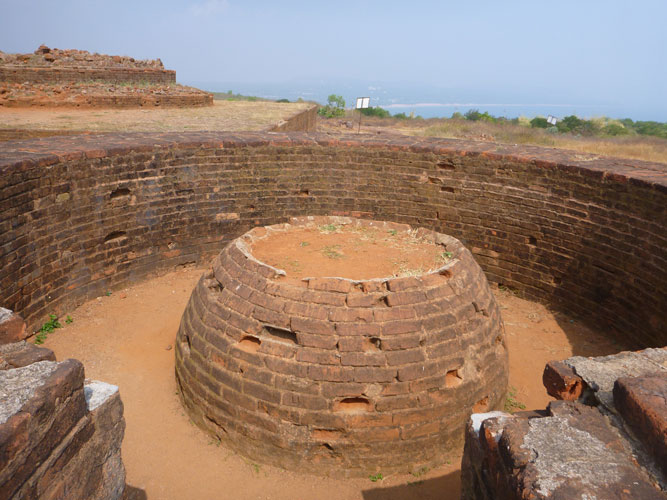
At Thotlakonda, worshippers once circumambulated this small stupa as well as the
large beyond on the left.
You can just see the shore of the Bay of Bengal in the distance.

Monks’ cells and yet more stupas at Bavikonda
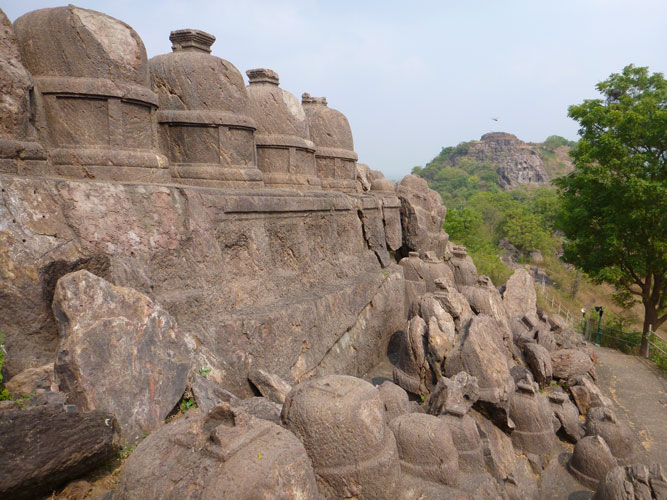
The two hills of Sankaram: The near one has a profusion of stupas.
You can make
out rock-cut caves and a large stupa on the distant hill.

Devas (angels) and disciples flank a Buddha at Sankaram.
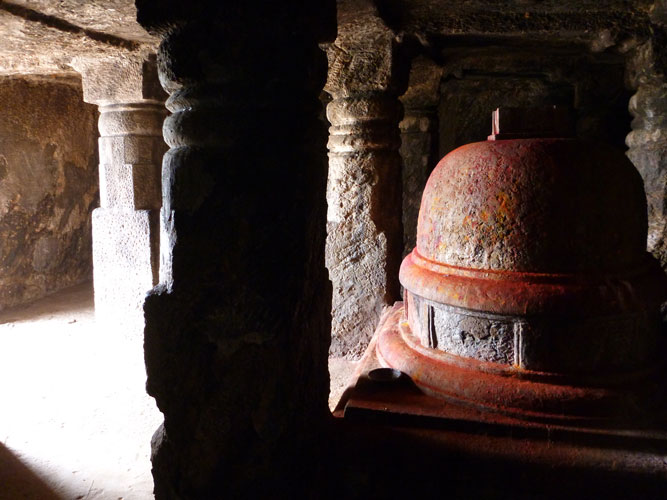
Inside the largest rock-cut cave at Sankaram

What kid wouldn’t enjoy a train ride? We are at the zoo just north of
Visakhapatnam.
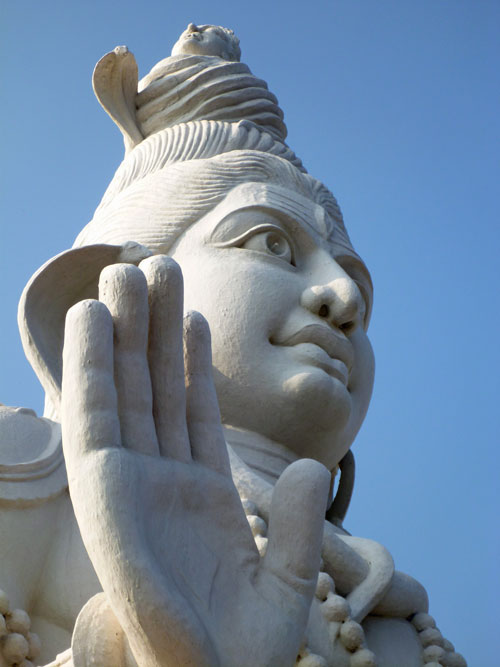
Shiva atop Kailasagiri Hill, also just north of Visakhapatnam.
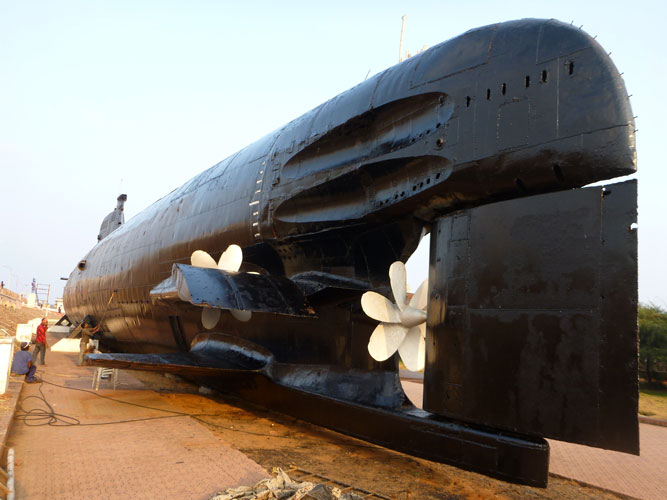
Touching up the paint of the Visakha Submarine Museum
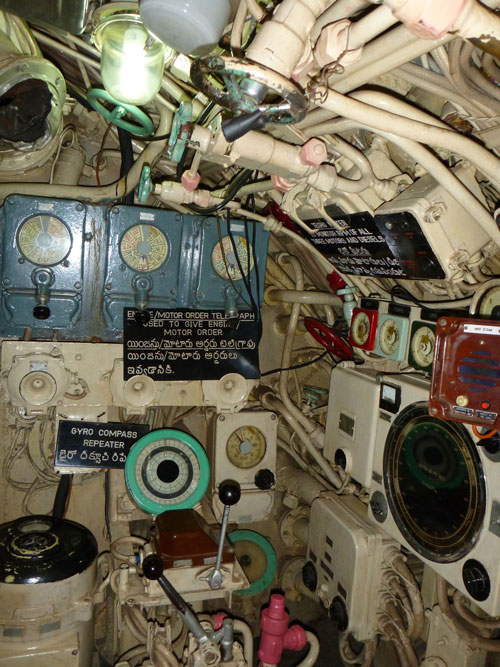
Steering controls in Visakha Submarine Museum
Koraput
For scenery and peace and quiet, I took a train journey northwest to Koraput
in a tribal area of southwestern Orissa state. I didn’t feel comfortable
dropping into tribal villages, but I took in the town’s Tribal Museum. The
hilltop Jagannath Temple is a smaller scale version of the great temple at Puri,
but unlike that one, here non-Hindus are welcome inside. Jagannath is the god
Vishnu as Lord of the World; he and many other gods also appear on the temple
exterior and in small shrines all around.
Vijayawada and Amravathi
In the port city of Vijayawada, I dropped by the curious little building of
the Victoria Jubilee Museum to see the sculpture and artifacts of long ago; the
1877 building honored the queen’s coronation jubilee, but is better known to
Indians as where India’s flag was first introduced in 1921. Undavalli Cave
Temples, just outside town, may have started as a Buddhist monastery around the
2nd century AD, then became a multi-level rock-cut Hindu temple around the 7th
century; it's fun to explore.
Farther up the Krishna River valley, Amaravathi is India’s largest stupa, yet it
takes a lot of imagination to visualize how it once appeared. There’s very
little left as most of the elaborate railings, gateways, and decorative covering
have scattered to museums. Luckily the nearby museum has many of the beautiful
white marble decorations such as lotus medallions, lions, garland motifs, and
worship scenes; there's a scale model as well.
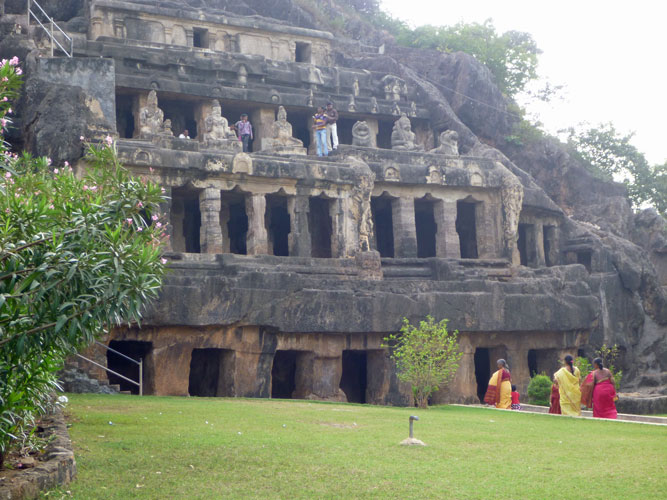
Undavalli Cave Temples honor the Trimurti—Shiva, Vishnu, and Brahma—in a
peaceful setting.

Inside one of the Undavalli Cave Temples

A row of gray stones once formed a railing around India’s biggest stupa at
Amaravathi.
Brick foundations in the foreground may have been part of a
monastery.
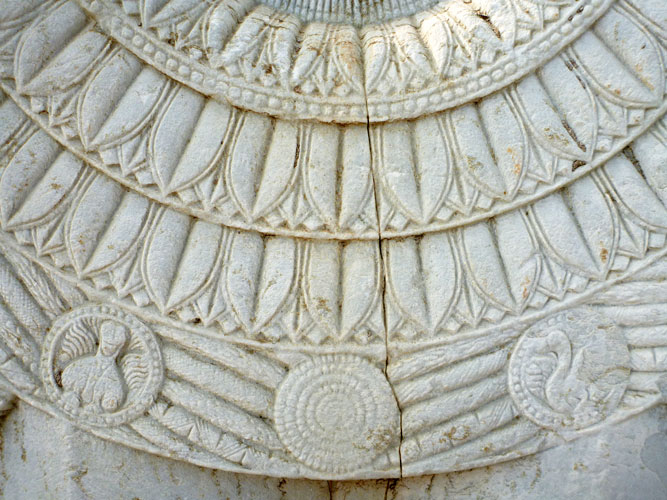
Detail of a lotus design from Amaravathi Stupa’s railing

This Dhyana Buddha, near Amaravathi Stupa, stands 20 meters high and
marks the
site where the Dalai Lama gave Kalachakra teachings in 2006.
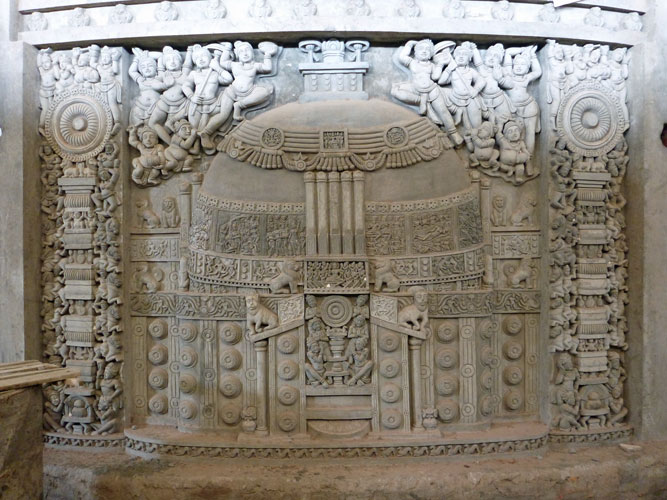
Reliefs inside the Dhyana Buddha give an idea of how Amaravathi Stupa once
appeared.
Amaravathi’s museum has original reliefs like this, but no photos are
allowed.
On to Hyderabad














